
Head Surgery Tools Page Menu: 1 2 3 4 5 6 Next>>
Head Surgery Tools From the Golden Age of Piracy, Page 2
Forceps
(Crow's Bill [Forceps], Raven's Bill [Forceps], Pincer, Pinser, Pincette)
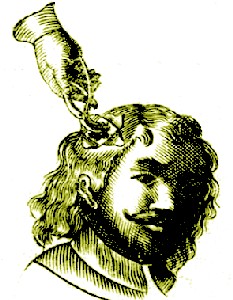
Spring Forceps Removing Splinters, Johannes
Scultetus, l'Arcenal de Chirurgie
(1597)
A variety of forceps are used in operations on a fractured skull because the fracture often produced slivers and chunks of broken bone that needed to be removed.
In his book, French surgeon Ambroise Paré provided a sketch of 'pincers' in the section on skull surgeries, which were one of several instruments he felt were "very necessary to take forth the scales of bones which are broken"1.
Paré's compatriot and son-in-law Jacques Guillemeau drew several types of forceps in his book for use by the surgeon to remove slivers of bone during head surgery including "O, O, The Rostrum lacerti [lizard snout or bill], which is verie conveniente to drawe out anye splinters of bone... P, The Ravens bille, in Latine called, Rostru[m] corvine[m]"2 and "A little pincette"3 for use in trepanning. The raven's bill forceps appear to be the same as the Paré's crow's bill forceps - the name raven is probably just the word the English interpreter of the original French book chose instead of the more widely supported crow. The curved 'lizard's snout' are unique among the types of forceps, however.
Sea surgeon John Woodall figures both a regular pair of forceps and a crow's bill forceps with a spring. (The spring would keep the forceps open when no pressure was placed on them.) French surgical instructor Pierre Dionis likewise figured a pair of "Forceps V, shaped like a Crow's bill" to be used to take loose splinters away.4
|
(1649) |
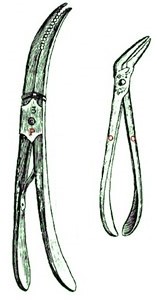 Guillemeau - Raven and Lizard Forceps (1597) |
 Guillemeau (1597) |
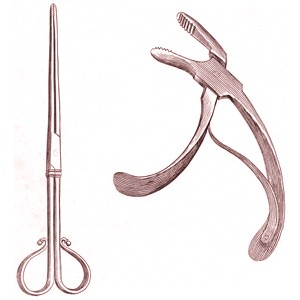 Woodall's Forceps - Regular & Crow's Bill (1639) |
 Dionis - Crow's Bill (1708) |

Guillemeau's
'Round pinsers'
For Retrieving the
Bone Chip
(1597)
In an account detailing a wound to the skull of a sailor who had been hit with a crow bar during boarding, sea surgeon John Moyle reported that the man had "two large Segments of the Bone beaten in, which lacerated the Crassior Tunicle [thick membrane]. These [bones] were instantly extracted with Forceps"5.
Multiple tools could be used as needed. In another case where a sailor fell off the forecastle and hit his head on a windlass, Moyle explained that a piece of bone sticking through the skull was "taken out with a small Levetor [elevator] and Forceps”6.
Sea surgeon James Yonge discusses how he removed a large piece of skull that he couldn't get previously due to its large size. "After some little time I did it [removed the large piece of bone], by turning it so that the narrowest part of it might come to the broadest of the Gap, when holding it fast with a Crow's Bill, it easily came forth."7
Forceps were also sometimes used to remove the round piece of bone left behind after the circular blade of a trepan had been used to drill through the skull. Jacques Guillemeau shows a pair of forceps specifically designed to remove the leftover bone circle after trepanning, which he explained were "Rounde pinsers, or tentacles, very necessary to take away the trepanned parcelle of bone."8 (See the image at right.) There was a flaw with such a tool, however. A trepanning kit typically contained at least three different sizes of trepans, which would produce three different bone chip sizes after the operation. This means if such a pair of forceps were to be used for every operation, the surgeon would need a pair sized for each different trepan blade.
1 Ambroise Paré, The Workes of that Famous Chirurgion Ambrose Parey, 1649, p.270; 2,3 Jacques Guillemeau, The French Chirurgerie, 1597, not paginated; 4 Pierre Dionis, A course of chirurgical operations: demonstrated in the royal garden at Paris. 2nd ed., 1733, p. 276; 6 John Moyle, Memoirs: Of many Extraordinary Cures, 1708, p. 3; 6 John Moyle, Memoirs: Of many Extraordinary Cures, 1708, p. 13; 7 James Yonge, Wounds of the Brain Proved Curable, 1682, p. 22-3; 8 Jacques Guillemeau, The French Chirurgerie, 1597, not paginated
Razors, Knives, Scissors and Scalpels

Razor, Johannes
Scultetus, l'Arcenal de Chirurgie
(1597)
Cutting instruments were an integral part of head surgery. One of the first things that had to be done to work on the head was to shave the part of the skull where the operation was to be performed, requiring the use of a razor. Since part of the sea surgeon's job was to barber the men, this would have been readily available to him. That wasn't necessarily the end of the razor's use in head wound surgery, however.
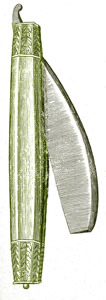
Razor, John Woodall,
The surgions mate (1639)
Once the head was shaved, the next step was often to search for a fracture in the skull after a traumatic head wound. If the fracture couldn't easily be located, the skin would be sliced open to bare the skull. French surgeon Ambroise Paré explained that when
the wound made in the musculous skin shall not be thought sufficient for ordering the fissure [in the skull], then must he [the surgeon] shave off the hair, and cut with a razour, or incision knife, the musculous skin with the Pericranium [Periosteum - the tough membrane under the skin covering the skull] lying under it, in a triangular or quadrangular figure to a proportionable bigness, alwayes shunning as much as in him lyes, the sutures and temples; neither must he fear any harm to ensue hereof; for it is far better to bare the bone by cutting the skin, then to suffer the kind & nature of the fracture to remain unknown, but a too religious preservation of the skin; for the skin is cured without any greate ado though pluckt off to no purpose.... Let this dissection be made with a razour, or sharp knife, and if there be any wound made in the skin by a weapon, let your incisions be made agreeable thereto.1

Razor, Ambroise Paré, The Workes of that Famous Chirurgion
Ambrose Parey, p. 265 (1649)
Paré further impressed upon the reader the use of the razor in this task, advising the surgeon that "the Musculous skin together with the Pericranium must be divided and cut with a sharpe razour pressed and guided with a strong and steddy hand".2
Paré thinks so much of the razor that he provides a figure of it by itself in his description on performing surgery on the skull, seen at left.
Slicing the Scalp With a Razor,
Johannes Scultetus (1666)
His description indicates that the instrument can be regarded as both a razor and a surgical knife. (It is notable that this instrument does not appear to fold like the other razors shown by authors in their texts on head surgery.)
A variety of other types of bladed instruments are discussed by other authors from this era. Matthias Gottfried Purmann suggests the use of "a Myrtiform Incision-knife, one End whereof is to cut through the fleshy Part of the Head, and the other to separate it from the Pericranium."3 French surgical instructor Pierre Dionis similarly suggests "with the Myrtle-Leaf-Knife E, [the surgeon] raises and widens the edges of [a] Wound"4.
Although not used for the same purpose, Dionis also recommends that his students use a 'Myrtle-leav'd Knife' after trepanning to extract the round bone chip left by the hollow, round trepan blade.5 Myrtle refers to the leaves of the flowering plant Myrtus communis, commonly found in Europe that have oval-shaped leaves that come to a gradual point, similar to that shown by Purmann in his drawing. (See figure 7 below.)
 Myrtiform or Myrtle-Leaved Knife, Matthias Gottfried Purmann, Churgia Curiosa, p. 4
(1706) Myrtiform or Myrtle-Leaved Knife, Matthias Gottfried Purmann, Churgia Curiosa, p. 4
(1706)
|
Dionis gives instructions for the use of a variety of bladed instruments for opening the scalp to detect fractures. He advises that injuries without a wound are
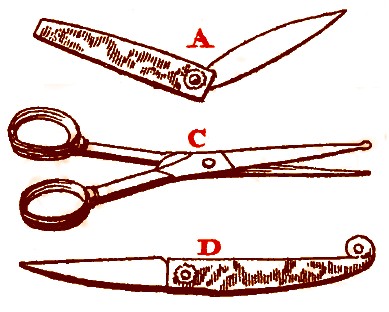
Cutting Instruments, Pierre Dionis, A course of chirurgical operations (1708)
immediately to be open'd by a cross Incision, which is made with the Abscess Lancet A. ...If 'tis a Wound and the Probe runs in betwixt the Pericranium and the Skull, he may slide in the Point of the Scissars C, the same way, and so discover [open up the membrane covering] the Skull; and when all is adherent, he uses the straight Incision Knife D, and resting his Fore-finger on the back of that Instrument, cuts through to the Cranium; ...and separating the Pericranium as gently as possible in order to abate the Pain, which never fails of being very pungent [painfully pricking] in that Moment by reason of the Tension of the nervous membranes, the Divulsion or Laceration of which are hereby occasion'd.6
Jacques Guillemeau describes a rather unique blade on a double-ended instrument used for cutting and scraping the scalp.
T, A rescindente [cutting] Instrumente, the one end whereof servethe for a rasore [razor], to cut throughe therwithe the musculouse skinne of the Heade, and also the Pericranium: which end is notede with X, and on the other end is it blunte, which is verye conveniente, to scrape the Pericranium, the same cleaving to fast unto the Craniu[m]: the which end is notede with V7
 A Scalpel and Scraping Instrument, From The French Chirurgerie, By Jacques Guillemeau
(1598) A Scalpel and Scraping Instrument, From The French Chirurgerie, By Jacques Guillemeau
(1598)
|
The last function of a bladed instrument is actually discussed in a later section that deals with cutting bone. Since we are discussing the use of regular knives, however, they are discussed here.
The first such bladed bone trimmer is suggested for use by Pierre Dionis after a hole has been cut in the skull. He says that "any

Lenticular Pen-Knife, Pierre Dionis,
Roughness at the bottom of the circular Hole, which may prick the Dura-Mater, and incommode it in its Motions, we cut them off with the Lenticular Penknife S, which we turn about the Circuit"8.
Sea surgeon John Woodall also uses a blade to remove bone. He explains, "I have my selfe with a short carving knife twise made as good shift [use] as if I had had a Trapan ready, and thereby cured two dangerous fractures, by cutting as much of the Cranium away, as that the contused blood had only vent."9
1 Ambroise Paré, The Workes of that Famous Chirurgion Ambrose Parey, 1649, p.265; 2 Paré, p. 266; 3 Matthias Gottfried Purmann, Churgia Curiosa, 1706, p. 4; 4 Pierre Dionis, A course of chirurgical operations: demonstrated in the royal garden at Paris. 2nd ed., 1733, p. 274; 5 Dionis, p. 284; 5 Dionis, p. 274-5; 7 Jacques Guillemeau, The French Chirurgerie, 1597, not paginated; 8 Dionis, p. 284; 9 John Woodall, the surgions mate, 1617, p. 6
Needle
The most suggestive use of a needle in head surgery is for suturing the wound on the skull. However, surgeons during the golden age of piracy did not do so, preferring to bandage such wounds and let nature heal them.
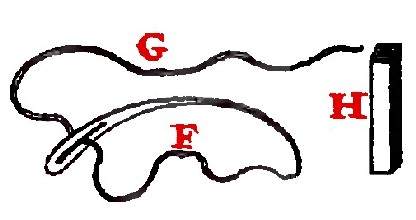
Needle, Thread & Bolster, Pierre Dionis, A course of chirurgical operations (1708)
This does not mean that a needle and suture material were never employed during head surgery, however. French surgeon Ambroise Paré explained that when "if it comes so to pass that the blood flows forth so violently, that it can be stayed by no means, the vessel it self must be bound"1. Suturing was an effective way to stop a bleeding artery with a ligature, something Paré proposed to avoid the painful cauterizing procedure which as most commonly followed procedure to arrest copiously bleeding wounds before his books were published.
Fellow French surgeon Pierre Dionis explains Paré's procedure in his book detailing the steps and tools used with the above diagram. He advises the surgeon "to pass through the curve Needle F, threaded with the wax'd Thread G, above the Vessel, which entring on one Side, and piercing the hairy Scalp, so that the Thread takes in the Artery, we herewith bind it up, making a Knot with the two ends of the Thread on a small Linen Bolster H; and, by this means, we securely stop the Flux of Blood, and avoid the Scar which the Vitrioline Button [a button-like piece of fabric containing a caustic medicine] would produce."2
1 Ambroise Paré, The Workes of that Famous Chirurgion Ambrose Parey, 1649, p.266; 2 Pierre Dionis, A course of chirurgical operations: demonstrated in the royal garden at Paris. 2nd ed., 1733, p. 275
Detecting Fractures
Before a decision could be made about the treatment a surgeon should employ for someone receiving a blow to the head, the surgeon needed to know whether the skull was fractured or not. This was not always obvious, even in cases where the skin was broken. If the patient was behaving in a way that suggested symptoms of a fracture after a head wound, the surgeon usually cut the skin to expose the skull and search for the fracture manually. Two tools were specifically employed to facilitate his search once the skull was bared: Ink and Probes.
Detecting Fractures: Ink
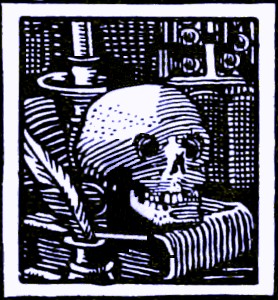
Artist: Harold Nelson and Mission
Ink was used on the skull to reveal hairline fractures that were not easily visible to the naked eye. Ambroise Paré explains the procedure:
...you must anoint as we told you before, the bared [skull] done with writing Ink, and a little Oyl of Roses; then the cleft or crack may be dyed or coloured therewith, if there be any there. Then the next dressing you must dry the bone with a linnen cloth, and scrape off the Ink, and oyl, with scraping Instruments made to that purpose, if any part thereof shall be sunk to the bone; for if there be any crack, it will be black1
The 'scraping instruments' that Paré refers to here could either be ink erasers which were used to scrape the ink off of documents or possibly the blade of a knife.
Sea surgeon John Moyle employed this method when treating a man who hit his head on a windlass. First he cleaned up the open wound and let the bone dry. Then "by rubbing Ink on the Bone, and then scalping [scraping] of it, [the ink] manifested all the rest of the Fissure"2.
1 Ambroise Paré, The Workes of that Famous Chirurgion Ambrose Parey, 1649, p.266; 2 John Moyle, Memoirs: Of many Extraordinary Cures, 1708, p. 13
Detecting Fractures: Probes
Metal probes were used for a variety of reasons during head surgery, detecting fractures being one of them. Jacques Guillemeau explains how a probe might be used in his description of the tool: "Y, A soundinge, or
![]()
Probe with Elevator, From The French Chirurgerie, By Jacques Guillemeau
(1598)
serchinge irone, to feele whether ther[e] be any fracture in the Cranium, the end wherof is rounde, and politelye polishede, and being of a reasonable crassitude [thickness] defigurede with Z, and on the other end a little elevatorye [elevator for raising the skull or bone fragments] notede with a."1
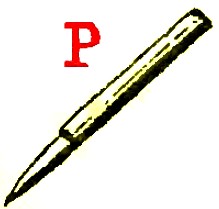
Quill Probe, Pierre Dionis, A course of
chirurgical operations (1708)
Pierre Dionis suggested a much more rudimentary hand-made probe be used when trepanning the skull for a similar purpose. "We probe the Circuit [cut] made by the Crown [of the trepan] with the Quill, cut like a Tooth-picker, to discover whether the Depth is equal, in order to lean the harder on that side of the Bone which is least cut [by the trepan]."2
Sea surgeon John Atkins likewise employed a probe, explaining that the reader was "to search the depth of the Bore with a Probe, and so the Surgeon may cut equally, by being informed at what Point to press hardest."3
Dionis recommended another type of probe when cutting the membrane on the skull in preparation for trepanning. He ordered the surgeon to "make use of the small flat

Probe, Pierre Dionis, A course of
chirurgical operations (1708)
Silver Probe B. ...If 'tis a Wound [in the skull] and the Probe runs in betwixt the Pericranium and the Skull, he may slide in the Point of the Scissars" to cut the pericranium.4
Sea surgeon John Moyle utilized a probe for yet another reason in one of his case studies - to clean the wound. Moyle explains that "the Ramenta [shavings] were remov’d with a soft Linteolum [small linen cloth]; and the grumous [clotted] Blood was remov’d by Lint on the end of a Probe."5
1 Jacques Guillemeau, The French Chirurgerie, 1597, not paginated; 2 Pierre Dionis, A course of chirurgical operations: demonstrated in the royal garden at Paris. 2nd ed., 1733, p. 284; 3 John Atkins, The Navy Surgeon, 1742, p. 87; 4 Dionis, p. 274; 5 John Moyle, Memoirs: Of many Extraordinary Cures, 1708, p. 13-4

